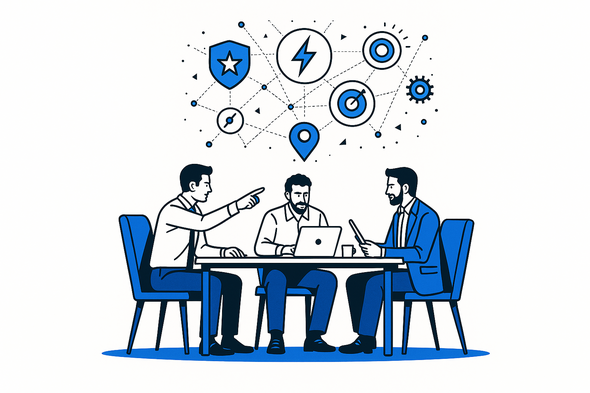Table of Contents
Breakfast Tastes Different When You’re Talking About Firing the Whole Team
The New Interview Loop: “Are You Ready to Replace the Team?”
Bold Truth #1: Automating Teams Isn’t Just Another Roadmap Item
Bold Truth #2: Leadership Skills Just Got a New Definition
The Playbook: Surviving AND Thriving in the AI Takeover
What AI-Driven Leadership Looks Like (It’s Not All Doom and Gloom)
Tension You Can’t Dodge: Accepting That Leadership Means Hard Choices
Table: Leading AI Automation in SaaS - What Works, What Fails
Recently, I had black coffee, a bagel, and a haircut-level reality check with the Chief Product Officer of a vertical SaaS company gunning for IPO. She’s ambitious, sharp, and no stranger to taking companies from $100M to $1B. We’re talking about someone who could build a rocket out of Legos and get it to land profitably. But the mission now? Full-on, all-in AI. Rip out the old systems (and the teams behind them), automate everything, and race the public markets. This is what product leadership interviews are turning into. And if you’re in R&D, product, or leadership - this conversation is already at your doorstep.
Breakfast Tastes Different When You’re Talking About Firing the Whole Team
There’s “let’s automate” and then there’s this conversation. The CPO put it on the table, plain and simple: “Hey, I know you have this team of SDRs, but we’re going to eventually get rid of them all once the AI is in place.” Next up? Lifecycle marketing. Customer support after that. No corner of the org was safe from the white-glove, machine-led future they were plotting.
A couple of bites later, she wanted to know about my own AI journey. Could I quarterback this automation rampage? Could I do it in a way that didn’t torch the culture or spook everyone out the door?
I get the urgency. AI is the new electricity. It’s running faster than most people realize, and it’s shaking up product leaders’ lives already. But there’s a hidden agenda - and a real human cost - behind the shiny vision slides. That’s the part most people miss.
The New Interview Loop: “Are You Ready to Replace the Team?”
Here’s the reality: product job interviews at fast-moving tech companies are morphing. People aren’t just being asked, “What’s your experience with AI?” They’re being asked things like:
- “Have you personally led a human-to-AI functional transition?”
- “Are you comfortable with change, even if it means eliminating roles?”
- “Can you do it nicely - without sparking panic or backlash?”
In my own work, I’m getting pinged for these projects constantly. The behind-closed-doors truth? You’re being measured on your ability to move fast, automate aggressively, and not break what’s left of morale. Everyone’s worried about their seat at the table - but not everyone knows how to make these moves without burning the house down.
Ready to drive more growth & achieve bigger impact?
Leverage my 25+ years of successes and failures to unlock your growth and achieve results you never thought possible.
Get StartedBold Truth #1: Automating Teams Isn’t Just Another Roadmap Item
You can’t treat “rebuild the business with AI” like optimizing the onboarding funnel. If you do, you’ll have a revolt on your hands - with good reason.
When I’m brought in for big transformation plays, here’s what I see on the ground:
- People know what’s coming. They’re reading the tea leaves, they see the pilot projects.
- Fear is contagious - especially among high performers worrying about being replaced, not upskilled.
- If you don’t over-communicate, you lose trust. And trust takes ten times longer to rebuild than AI takes to write a cold outreach script.
The CPO leaned in and said, “I want this process to be humane, but I know what’s necessary. You in?” The way I see it, nobody ever said: “Well, the hangman was pretty nice about it.” And I’m not here to make that my legacy.
Bold Truth #2: Leadership Skills Just Got a New Definition
Being “nice” isn’t enough. “Empathic automation” barely exists. This is about being ruthlessly clear, straight with your people, and honest about what the business needs. I style myself more Wolf from Pulp Fiction than Ted Lasso. When execs call me, it’s because fast results matter, and the CEO cannot afford for the initiative to fail.
Your leadership credibility gets tested here. If you try to sugarcoat it, people see right through you. High-integrity leaders:
- Lay out the macro trend (AI’s coming for almost every repeatable task)
- Spell out what will really change, when, and why
- Stand behind the uncomfortable trade-offs, instead of hiding behind corporate platitudes
Check out Leadership Skills For Executives for more on how to do this without losing the team.
The Playbook: Surviving AND Thriving in the AI Takeover
Let’s get practical. If you’re a product or R&D leader, here’s what’s actually working when you’re asked to drive these shifts:
- Be brutally transparent early - If you know AI is coming for someone’s domain, don’t wait to have the talk.
- Over-index on communication, under-index on “motivation” hacks - People will hear about layoffs. You can’t trick them into feeling safe - only build trust by sharing facts.
- Make a map of “What AI Can Do Now” vs. “What Still Needs Judgment” - and show it. Help people see where their best skills align with what’s next.
- Coach for, don’t control - The top 10% will find new value to deliver if you help them see what’s needed. The rest may opt out - and that’s ok.
Want to go deeper? See How To Lead Your Team When It Feels Like The Ground Is Shifting for specific tactics and war stories.
Ready to drive more growth & achieve bigger impact?
Leverage my 25+ years of successes and failures to unlock your growth and achieve results you never thought possible.
Get StartedWhat AI-Driven Leadership Looks Like (It’s Not All Doom and Gloom)
I see execs making two big mistakes here. Some get gridlocked by guilt and try to “save” everyone. Others go clinical: “Let’s deploy AI and whoever can’t keep up gets cut.” Both miss the mark.
The best play is to:
- Get ahead of the fear, and say what others are dodging
- Offer reskilling and upskilling - but don’t pretend every role can cross the chasm
- Treat layoffs as a fact, not a personal failure
- Invest most in the survivors, not just the newly automated
Here’s how this plays out with leaders I coach. The ones who thrive:
- Are clear-eyed about what’s happening (and why)
- Don’t disappear when things get tense - they double down on 1:1s and open office hours
- Remember: automation is about freeing up talent, not just cost cutting
And when you get it right, you can actually create the kind of team that’s building effective teams for the world that’s already here - not mourning the one that’s gone.
Tension You Can’t Dodge: Accepting That Leadership Means Hard Choices
Making these calls never gets easier. I coach execs through calls where they’re laying off teammates they’ve worked next to for years. It’s brutal. The only way through is to connect it to the greater mission: If you’re not transforming, someone else will.
Here’s the question I ask my leaders:
Are you being a caretaker for a legacy org, or are you writing the org chart for what the company must become?
The healthiest teams treat automation - whether partial or total - as an evolution, not a guillotine. But yes, there are unavoidable exits, and you need backbone to push through. See Lessons From Real Performance Management Conversations That Got Tricky if you want to understand how this gets handled at the next level.
Ready to drive more growth & achieve bigger impact?
Leverage my 25+ years of successes and failures to unlock your growth and achieve results you never thought possible.
Get StartedTable: Leading AI Automation in SaaS - What Works, What Fails
| Scenario | What Works | What Fails |
|---|---|---|
| Early warning to teams | Communicating AI plans honestly and early | Hiding plans; last-minute shocks |
| Transitioning SDRs to AI | Offer reskilling, outline new opportunities | “Surprise, you’re gone” emails |
| Explaining “why” behind changes | Tie tech changes to company vision and strategy | Speaking corporate-ese |
| Handling reduction in force (RIF) | Treat with dignity, clear timeline, support outplacement | Ghosting; rumor mills |
| Surviving product leads | Double-down on 1:1 coaching, map new skill needs | Expecting people to “figure it out” |
| Communicating with remaining team | Regular updates, open Q&A, no spin | Celebrating too soon, acting relieved |
| Long-term buy-in | Focus on freeing up value, not just cost savings | Only talking about headcount saved |
One More Coffee: What This Means for You
Let’s call it what it is. Three years ago, being a product leader was about managing velocity, wrangling roadmaps, and unblocking smart people. Today, it’s about guiding your team through the AI storm. You’ll be asked to lead, follow, or get out of the way. The breakfast table is set. Which seat are you choosing?
Here’s the thing nobody frames plainly: you can’t outsource this kind of leadership to HR, or wait for the board to set the tone. If you’re a product leader, how you handle this - AI-driven change, the hard conversations, and the people decisions - is your legacy.
Where do you stand? How will you talk about this five years from now, when AI has taken over the “easy” work and only the truly adaptive, resourceful teams remain? The future is arriving fast, company by company, breakfast by breakfast. Step up, or step aside.
Want more tactical, honest advice from the front lines? I’ve written about navigating executive interpersonal dynamics and sustaining momentum within product development teams that can help you not just survive the storm, but harness it.
The AI era is no longer “on the way.” It’s here, biting at your org chart and spitting out new rules. Adjust fast, talk straight, and don’t forget the human side. Otherwise, trust me - your next breakfast meeting will taste a whole lot stranger.
Ready to drive more growth & achieve bigger impact?
Leverage my 25+ years of successes and failures to unlock your growth and achieve results you never thought possible.
Get Started



